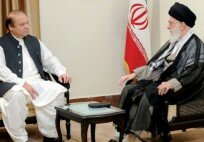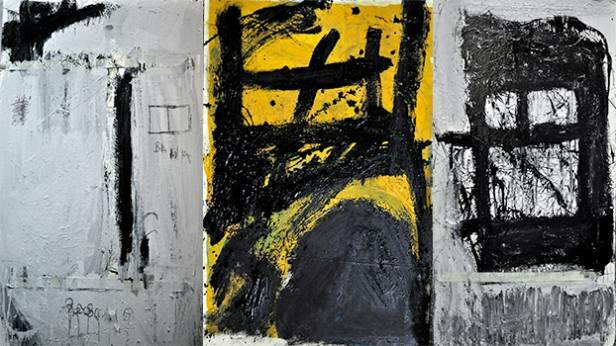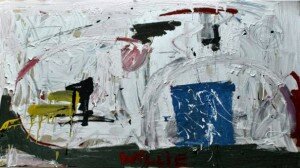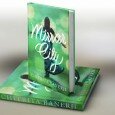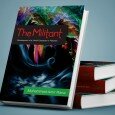By Aasim Akhtar –
The weather is heavy in Ali Sultan’s new paintings, where paint surges, lines whip and skid, and fragmentary forms collapse, inflate and slam into each other. Words have a longstanding place in Sultan’s work, often formed in a way that links their invisible shape to their voiced sound, and to their origin in breath and body. The works’ range of social and cultural observation is matched by an extravagantly free dispersal of mediums across a variety of supports. Sultan produces surfaces that are variously rococo, catastrophic, sparkly and black as dried blood.
The more you look at them, the more you become aware of a disconnect between actual perception and retinal afterimage, which causes the work to appear to reverberate gently, setting up what Robert Irwin calls a ‘hum’. There is also a sense of light emanating from the centre of each work, as if from a window. There is a solemnity here that society generally reserves for momentous occasions, and there’s a gentle irony in Sultan’s celebration of the non-death of painting with images that resemble nothing so much as death announcements. Is it possible, Sultan asks in these works, to create a vital painting that did not depend in any way on illusion, content or even quality of mark, that was about its own architecture, its actual physical structure? It’s marvelous to remember – given the current artistic climate, in which anything goes – that people once actually cared about such things.
While Sultan’s premise is intellectual, the result is work of great formal beauty, which, whether he wanted it to or not, delivers an emotional impact even in its restraint, a feeling of tranquility engendered by a certain perfection in proportion and execution. It’s similar to the way a Shaker house is devoid of overt decorative expression, yet the ‘rightness’ of simple elements creates a serene, irreducible presence. Sultan’s paintings are also formal in the non-art sense of black ties and long white gloves; one walks to stand up straighter in their presence.
Ali Sultan’s debut exhibition, organized by Gallery 39 K, had all of the textural richness of a fugue. His paintings contain strata of concealed imagery and sometimes embedded objects. His photographs are occasionally painted on, after being printed from negatives he has altered and scratched. Such interweaving and layering feeds into the reciprocity of the artist’s working process. The work’s own emphasis on fundamental emotions and conditions (tenderness, sadness, grace), the show came across as uncommonly concentrated, less like a fugue than the clear, resonant tone of a single bell. Though physically imposing on occasions, the paintings feel restrained, purposefully quiet. Painted in oil and enamel on Masonite panels on grounds of emulsified gesso or primer, their surfaces are dark and rich, fertile as humus and primal. They oscillate between thick and thin, matte and glossy, dense and translucent. In places, paint drips in thinned streaks. In others, the artist furrows into deep, viscous enamel. An animate darkness presides. The warm, brownish black evokes neither night nor despair, but a primary condition, a place of beginning, anterior to light and language. Into this rich silence, Sultan voices his world, one element at a time.
Rugged textures and translucent veils in the paintings convey a sense of shifting space, space-in-process. These are staging grounds for becoming, rather than fixed locales. Sometimes, the paintings with their historical titles such as ‘Don Quixote and Sancho Panza’ and ‘Queen Jane Approximately’ seem like portraits of the introspective self, reckoning with the circumstances of loss, transcendence, memory and impermanence that have shaped Sultan’s sensibility. His process pivots on both faith and doubt. Faith in a medium’s possibilities fuels his efforts; doubt in its capacity to measure up to the intensity of lived experience infuses those efforts with an aching sense of displacement.
Working in numerous mediums concurrently, he remains acutely conscious of the limits of each. He wrestles, through his work, with the prospect of meaning being located just beyond the boundaries of expression. In ‘To Repel Ghosts’, he painted in white over a page of found writing, and then adhered the page to a larger canvas. A cycle of searching, defining and undermining plays itself out openly here. It’s a process that is also at work in other canvases, with their images buried under layers of blackness. Clashes between affirmation and denial, repair and violence, redemption and loss all lend their friction to his work.
Ali Sultan practices a kind of blunt poetry of essentials, stripped of small talk, using a palette of charged, basic tones – milk, earth, blood and light. Sultan, like Guillermo Kuitca, asserts the validity of a personal, bodily geography, in which demarcation of territory parallels the articulation of experience and meaning. He channels our attention to what is absent. What isn’t represented then becomes emblematic of what cannot be represented – an entirety, a full understanding of the workings of consciousness.
In his paintings, Ali Sultan cuts and mends, buries and excavates. He pairs the extremes of tar black and milk white. Throughout, he reckons with time’s duality – its generosity in bestowing beauty and love, its violence in cancelling them both out. He trusts the authority of silence and the truth in contradiction. “Is the record of our loneliness the best we leave behind of ourselves?” It may be so, but it also may be enough. In the record of Sultan’s inner silences, there is profound beauty, and it proves to be a powerful form of communion.
The writer is a curator and an art critic





























































